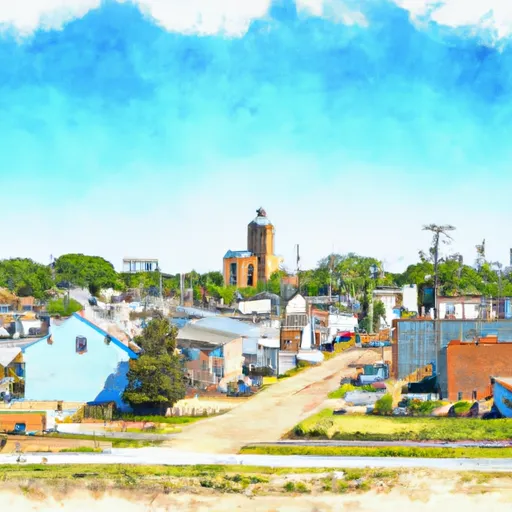-
 Snoflo Premium
Snoflo Premium
Get unlimited access to all our content
With no Ad interruptions! - Start Your Free Trial Login with existing account
Howard
Eden Index
Climate
8.3
•
Recreation
2.6
•
Community
0.7
•
Safeguard
4.4/10

Howard, Kansas is a small town located in Elk County. The climate in Howard is classified as a humid subtropical climate, with hot and humid summers and mild winters. The average annual temperature is around 60°F, with temperatures ranging from highs of 90°F in the summer to lows of 30°F in the winter. Precipitation is evenly distributed throughout the year, with an average of 40 inches annually.
The hydrology constituents in Howard are mainly influenced by the Elk River, which flows through the town. The river provides opportunities for fishing and boating, with various species of fish including bass, catfish, and crappie. Additionally, Elk City Lake, located nearby, offers recreational activities such as swimming, camping, and hiking.
Outdoor recreation opportunities abound in Howard. The town is surrounded by picturesque landscapes, making it ideal for activities such as hiking, birdwatching, and wildlife spotting. The Elk City State Park, just a short drive away, offers a multitude of recreational activities including horseback riding, mountain biking, and picnicking. With its diverse climate, hydrology constituents, and abundant outdoor recreation opportunities, Howard, Kansas is a charming destination for nature enthusiasts and those seeking a tranquil getaway.
What is the Eden Index?
The Snoflo Eden Index serves as a comprehensive rating system for regions, evaluating their desirability through a holistic assessment of climate health, outdoor recreation opportunities, and natural disaster risk, acknowledging the profound impact of these factors on livability and well-being.
Climate Health Indicator (CHI): 8.3
Howard receives approximately
968mm of rain per year,
with humidity levels near 81%
and air temperatures averaging around
14°C.
Howard has a plant hardyness factor of
6, meaning
plants and agriculture in this region thrive during a short period during spring and early summer. Most
plants will die off during the colder winter months.
By considering the ideal temperature range, reliable water supplies, clean air, and stable seasonal rain or snowpacks, the Climate Health Indicator (CHI) underscores the significance of a healthy climate as the foundation for quality living.
A healthy climate is paramount for ensuring a high quality of life and livability in a region, fostering both physical well-being and environmental harmony. This can be characterized by ideal temperatures, reliable access to water supplies, clean air, and consistent seasonal rain or snowpacks.
Weather Forecast
Streamflow Conditions
Verdigris
Area Rivers
Verdigris
Snowpack Depths
Verdigris
Reservoir Storage Capacity
Verdigris
Groundwater Levels
Recreational Opportunity Index (ROI): 2.6
The Recreational Opportunity Index (ROI) recognizes the value of outdoor recreational options, such as parks, hiking trails, camping sites, and fishing spots, while acknowledging that climate plays a pivotal role in ensuring the comfort and consistency of these experiences.
Access to outdoor recreational opportunities, encompassing activities such as parks, hiking, camping, and fishing, is crucial for overall well-being, and the climate plays a pivotal role in enabling and enhancing these experiences, ensuring that individuals can engage in nature-based activities comfortably and consistently.
Camping Areas
| Campground | Campsites | Reservations | Toilets | Showers | Elevation |
|---|---|---|---|---|---|
| Caney Bend | 5 | 800 ft | |||
| Osage Hills State Park | None | 785 ft | |||
| Rock Ridge Cove North - Fall River Lake | 45 | 973 ft | |||
| Sedan City Park | 15 | 843 ft | |||
| Fall River State Park | 165 | 995 ft | |||
| Feyodi Creek RV Park | 54 | 755 ft | |||
| Hominy Municipal Lake | None | 895 ft | |||
| Moline City Park | None | 1,040 ft | |||
| Bluestem Lake | None | 915 ft | |||
| Wah - Sha - She State Park | None | 771 ft |
Nearby Fishing
Catastrophe Safeguard Index (CSI):
The Catastrophe Safeguard Index (CSI) recognizes that natural disaster risk, encompassing floods, fires, hurricanes, and tornadoes, can drastically affect safety and the overall appeal of an area.
The level of natural disaster risk in a region significantly affects safety and the overall livability, with climate change amplifying these risks by potentially increasing the frequency and intensity of events like floods, fires, hurricanes, and tornadoes, thereby posing substantial challenges to community resilience and well-being.
Community Resilience Indicator (CRI): 0.7
The Community Resilience Indicator (CRI) recognizes that education, healthcare, and socioeconomics are crucial to the well-being of a region. The CRI acknowledges the profound impact of these elements on residents' overall quality of life. By evaluating educational resources, healthcare accessibility, and economic inclusivity, the index captures the essential aspects that contribute to a thriving community, fostering resident satisfaction, equity, and social cohesion.

